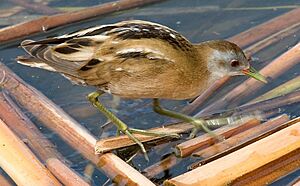Little crake facts for kids
Quick facts for kids Little crake |
|
|---|---|
 |
|
 |
|
| Male above, female below | |
| Conservation status | |
| Scientific classification | |
| Genus: |
Zapornia
|
| Species: |
parva
|
 |
|
| Range of the little crake Breeding Passage Non-breeding Extant (seasonality uncertain) | |
| Synonyms | |
|
Gallinula minuta Montagu, 1813 |
|
The little crake (Zapornia parva) is a very small waterbird. It belongs to the Rallidae family, which includes rails and coots. The word parva comes from Latin and means "small," which perfectly describes this tiny bird. For a long time, this species was known by the name Porzana parva.
Contents
What Does a Little Crake Look Like?
Little crakes are small birds, usually about 17 to 19 centimeters (about 7 inches) long. They are a bit smaller than the spotted crake. You can tell them apart because little crakes don't have dark stripes or white spots on their sides.
Colors and Features
The little crake has a short, straight beak that is yellow with a red base. Their legs are green with long toes, and they have a short tail. The underside of their tail has black and white stripes.
Male vs. Female
Male and female little crakes look different, which is called sexual dimorphism.
- Adult males have mostly brown feathers on their upper body. Their face and underside are blue-grey.
- Females have buff (light yellowish-brown) feathers on their underside. Only their face is grey.
- Young little crakes look similar to females but have a white face and chest.
- Like all rails, baby little crakes are covered in black, fluffy down feathers.
Where Do Little Crakes Live?
Little crakes live in reed beds, which are areas with tall grasses called reeds, often near water. They breed mainly in Europe, especially in the eastern parts, and also in western Asia.
Migration
These birds are migratory. This means they travel long distances between their breeding grounds and their winter homes. When winter arrives, little crakes fly south to Africa. They spend the colder months there before returning to Europe and Asia to breed again.
What Do Little Crakes Eat?
Little crakes use their beaks to search for food in mud or shallow water. They also pick up food they see. Their diet mainly consists of insects and other small animals that live in the water.
Behavior and Sounds
Little crakes are very shy, especially during the breeding season. This makes them hard to spot, so you are more likely to hear them than see them. They become a bit easier to see when they are migrating.
Calls
These birds can be quite noisy. They make a yapping sound that sounds like "kua."
Reproduction and Life Cycle
Little crakes build their nests in dry spots within the reed beds. A female little crake usually lays between 4 and 7 eggs.
Conservation
The little crake is one of the species protected by the Agreement on the Conservation of African-Eurasian Migratory Waterbirds (AEWA). This agreement helps protect birds that migrate across Africa and Eurasia.



